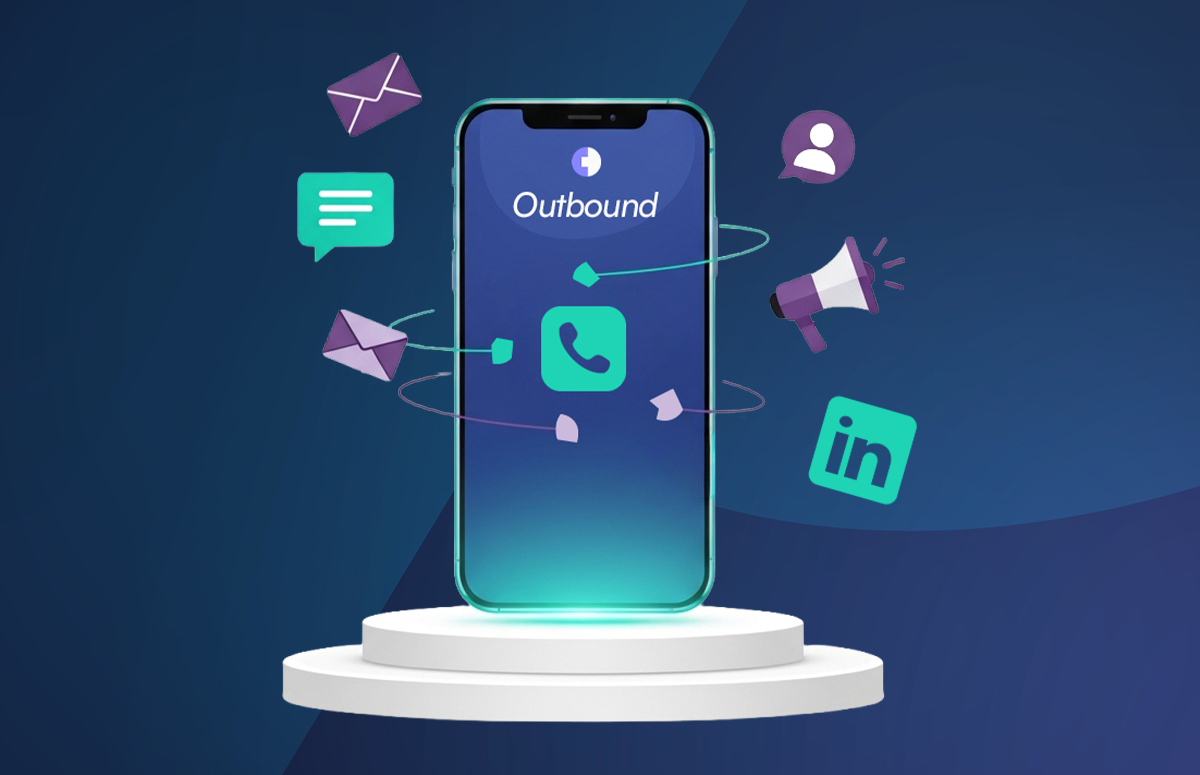Date-a-vendor Allbound Playbook: From First Glance to Full Funnel
By: Sam Gocher
Sales, Demand Generation, Outbound, Marketing, Revenue Operations, Email Marketing, Email, Thought Leadership
What's on this page:
So, you’ve found a data partner worth sticking with. The prospecting profile is crisp, the intent signals are strong, the enrichment runs like clockwork.
Now comes the good bit: turning those early sparks into a true full-funnel romance.
This is the part where inbound and outbound stop playing in separate sandboxes and start building something real together. A unified go-to-market motion. Shared lists, shared goals, and a shared understanding of what makes your dream prospects actually convert.
It’s no longer “who sourced the lead,” but “how are we nurturing this relationship?”
Allbound isn’t a tactic, it’s a mindset. It’s the decision to stop treating leads like one-night stands and start building the kind of multi-touch journeys that turn interest into intent, and intent into revenue.
We’ll walk through:
💘 What an allbound-ready list really looks like
💌 How inbound and outbound can co-own intent
🎯 Matching messaging and channels for full-funnel impact
📊 Measuring conversion, influence, and pipeline lift
⚡ Why alignment is your biggest lever for long-term revenue
Let’s kick things off where every love story starts: seeing your type in the wild.
Know Your Type: Building a Unified Audience Model 💘
You’ve already got inbound campaigns pulling in form fills and MQLs, while outbound is chasing signals across email, phone and LinkedIn.
But if those teams are working from different lists, definitions, and signals, the result isn’t synergy; it’s misalignment in disguise.
The best allbound strategies start with a single source of truth: one prospect universe, one ICP model, and one shared list that sales and marketing actually trust.
Merge your feeds ✅
Pull in CRM records, website visits, third-party intent data and enrichment sources into one central list.
Whether a lead arrived via Google Ads, a webinar, or cold outreach, they’re part of the same buying journey now.
This shared list model is core to any aligned go-to-market motion. More info in our Date-a-vendor Modelling Playbook: Inbound & Outbound, an Allbound Love Story.
Deduplicate ruthlessly ✅
Duplicates confuse attribution, waste SDR effort and screw up nurture timing. Treat them like bad dates: one strike and they’re out.
Tag with context ✅
Not all leads are born equal.
Use lead source tags like “inbound form fill,” “content download,” or “outbound sequence” so SDRs and marketers know where the spark started and can tailor their follow-up accordingly.
Inline Note:
A unified prospect list isn’t just a cleaner database. It’s the foundation for joined-up messaging, intent sharing, and coordinated multi-touch follow-up that feels intentional rather than random.
Build Your Type: One Unified ICP to Rule Them All 💁♀️
You can’t build an allbound motion without alignment, and alignment starts with one shared definition of who you’re trying to reach.
Inbound can’t optimise for content downloads while outbound targets a different persona. Paid can’t promote to Finance while SDRs chase RevOps. When every team works from a different idea of the ideal customer, the result is disjointed journeys and wasted spend.
To avoid this, your first priority is a unified Ideal Customer Profile (ICP), one that’s built for every channel.
What makes a strong allbound ICP?
A shared ICP needs to balance firmographic, technographic, and behavioural data to help teams focus on buyers who are not just a good fit, but also likely to engage.
|
Attribute Type 📋 |
Why It Matters 🤔 |
Example Filters ⌨️ |
|
Firmographics |
Helps target by size, industry, region |
B2B SaaS, 200–1,000 employees, UK + DACH |
|
Technographics |
Reveals compatibility or opportunity |
Salesforce users, ABM tool installed |
|
Intent Signals |
Indicates timing and priority |
Competitor research, pricing page visits |
|
Behavioural Triggers |
Flags recent activity that suggests readiness |
Job changes, webinar views, ad engagement |
By centralising this model in your CRM or data platform, and ensuring everyone uses it, you set a consistent baseline for both inbound and outbound plays.
🧠 Top tip:
Keep your ICP fluid. Revisit it frequently using conversion and retention data to validate who’s engaging, who’s converting, and who’s sticking around.
That way, you’re not just targeting the “ideal”, you’re targeting the proven.
Segment for Chemistry, Not Just Coverage 💔
Having one ICP is the foundation, but to make your allbound strategy sing, you need segmentation that reflects real-world behaviour, not just surface-level traits.
Not every high-fit lead is ready for the same type of conversation. Some need education, others need urgency. Segmenting your audiences helps each GTM team engage with the right message, at the right time, in the right way.
How to segment for allbound orchestration
|
Segment Type 🧍♂️ |
What to Consider 🤷♀️ |
Channel Impact 👊 |
|
Buying Stage |
Are they problem-aware? Solution-aware? In-market? |
Align content, cadence, and CTA to funnel position |
|
Persona |
What does this role care about? What’s their pain? |
Personalise value props across sales and marketing |
|
Engagement Level |
Are they clicking ads? Opening emails? Attending events? |
Prioritise timing and intensity of follow-up |
|
Trigger Activity |
Have they had a job change? Just raised funding? |
Use real-time alerts to launch timely plays |
Build tiered segments for precision
A solid framework for allbound might look like this:
|
Tier |
Description |
Recommended Motion |
|
Tier 1️⃣ |
High-fit + high intent |
Immediate SDR outreach + retargeting ads |
|
Tier 2️⃣ |
Good fit, moderate engagement |
Nurture via email + mid-funnel content |
|
Tier 3️⃣ |
Light signals or passive interest |
Awareness campaigns + brand touchpoints |
🧠 Top tip:
Segments should be dynamic, not static. Feed them with real-time signals from across channels so your lists evolve as buyer behaviour changes.
This approach to real-time segmentation is key in modern GTM teams! You can find out more about this in our Date-a-vendor Evaluation Playbook #4: ‘We Need to Consolidate Vendors’.
Enrich to Impress: No More Guesswork 🕵️♀️
Allbound only works when everyone’s singing from the same sheet, and that means the records in your CRM need more than just a name and job title.
Enrichment is where your model moves from “basic bio” to “dating profile that actually gets replies.” You’re not just looking for prospects, you’re uncovering context.
✨ Here are five data layers for your GTM team to get their hands on:
|
Data Layer |
What It Reveals |
Why It Matters |
|
Contact info |
Verified email and mobile numbers |
Reduces bounce risk, unlocks phone outreach |
|
Technographics |
Tools and platforms they use today |
Supports integration messaging, competitive plays |
|
Intent signals |
Topics they’re researching or engaging with |
Highlights who’s in-market now |
|
Firmographics |
Company size, sector, location |
Tailors messaging and routes to correct reps |
|
Trigger events |
Hiring sprees, funding rounds, leadership changes |
Fuels timely outreach with personalised hooks |
Why enrichment powers allbound
- Marketing builds ad and email audiences with more precision.
- SDRs start conversations based on facts, not assumptions.
- Ops can route leads automatically based on territory or tier.
- Leadership sees cleaner attribution and faster velocity.
🔁 Bonus tip:
Set a refresh cadence. Enriched data goes stale fast — especially job titles, mobiles and intent signals.
Monthly updates mean you’re always working with the best info possible.
Use Signals to Pick the Right Moment 🕰️
Timing is everything in modern go-to-market.
You might have the perfect message and the ideal prospect, but if you reach out before they’re ready, you’ll get ghosted. Allbound strategies only work when your timing aligns with real buying behaviour.
That’s where signals come in, behavioural breadcrumbs that reveal when someone’s actually in-market.
There are two main categories to layer into your model:
Intent signals
These tell you when someone’s showing interest in your category or adjacent solutions. Think:
- Researching relevant topics on third-party sites.
- Downloading similar tools or comparison content.
- Returning to your website’s high-intent pages (like pricing or case studies).
Trigger events
These are changes that signal a potential buying window. For example:
- A new Head of Sales joins the business.
- They raise a funding round or announce rapid hiring.
- They start using a tool your product complements (or replaces).
Alone, these buying signals aren’t enough, but combined with ICP fit and past engagement, they help you prioritise who’s leaning in and who’s just browsing.
They also give you messaging fuel. If someone’s just hired a new CRO, your email shouldn’t sound generic. It should acknowledge the change and show relevance.
Sales teams can’t always rely on surface-level engagement. Sometimes, what sounds like a brush-off is actually a strong buying cue.
Shivan Pillay, Cognism’s Sales Coach & ‘Why Did It Fail?’ podcast host, says:
“One of the biggest buying signals we look for is when a prospect says they’re too busy, that they’ve got too much going on. That’s often exactly when we can help. It's actually a signal, not an objection.”
💡 Practical tip:
Integrate your signal stack directly into your scoring or routing logic.
If a lead matches your ICP and they’ve hit two or more signals in the last 14 days, that’s your cue to move.
Don’t Just Coordinate, Orchestrate 🎼
Allbound isn’t just about running inbound and outbound in parallel, it’s about synchronising them so they reinforce each other.
When you orchestrate correctly, each channel boosts the impact of the others, creating momentum instead of noise.
Think about how your prospects experience your brand: a well-timed email might get their attention, but if they see a relevant ad before that, or read a blog post days earlier, it lands differently.
And if an SDR follows up referencing that exact content? You’ve got a real shot at engagement.
Here’s how to build that kind of orchestration into your model:
Align on audience and timing
Start by agreeing on your target list and sequencing windows across teams.
You might not want marketing running paid campaigns to one segment while SDRs are emailing another. Get in the same room, literally or virtually.
Share a central signal pool
Sales and marketing should pull from the same pool of behavioural data, page visits, ad clicks, webinar registrations, so they’re not duplicating effort or missing opportunities.
Map touchpoints across the funnel
Define what happens when a lead enters via a blog download versus an outbound touch.
Who follows up, how quickly, and with what message? Build these flows out in your CRM or automation platform to ensure consistency.
Measure influence, not just source
Attribution shouldn’t be a fight. Allbound success isn’t about whose lead it was, but how many channels helped move them forward. Use multi-touch tracking to show the cumulative effect of outbound, inbound and everything in between.
When allbound works, it feels like a conversation, not a campaign. Every message connects. Every touchpoint builds trust. And the prospect moves naturally from awareness to interest to action.
Workflows That Turn Signals Into Sequences 🔁
Allbound doesn’t mean more noise; it means smarter automation.
Once you’ve got shared signals and a unified list, the next step is activating that data with workflows that feel timely, personal and relevant across every touchpoint.
Modern GTM teams don’t have the luxury of manual follow-ups. The magic lies in building sequences that respond to behaviour in real time, without feeling robotic.
Here’s how to do it:
Define trigger events clearly
Set specific behavioural or demographic signals that kick off outreach. Think:
- Downloaded a mid-funnel guide.
- Visited your pricing page more than once.
- Was added to your CRM from a paid ad campaign.
Each trigger should map to a distinct action, whether that’s SDR outreach, a nurture email, or ad retargeting.
Layer in context for personalisation
Triggering outreach isn’t enough, you need to personalise it. Pull in relevant enrichment fields (job title, tech stack, campaign source) to build messaging that feels handcrafted, even when it’s automated.
Knowing what to automate is one thing, knowing how to personalise that automation without sounding forced is another.
Shivan says:
“There’s no silver bullet, it’s trial and error. We coach reps to test different approaches, listen back, and refine until they find the version that’s them. It has to sound like you, not like a sales script.”
Connect systems for scale
Allbound orchestration only works if your tech stack is speaking the same language.
Sync data between your CRM, email platform, ad tools and intent provider so each team sees the same signals, and can act fast.
Use branching logic in your cadences
Not all prospects engage the same way. Use conditional logic to adapt your workflows:
- Opened email but didn’t click? Try a softer follow-up.
- Attended webinar but didn’t book a meeting? Serve a related case study ad.
- Ignored outreach? Drop them into a longer-term nurture flow.
Automate responsibly
The goal isn’t to overwhelm your prospect, it’s to meet them with the right message, at the right time, in the right format. Avoid overloading by setting throttling rules, deduplication logic, and channel frequency caps.
Done right, workflows become your GTM team’s secret weapon, turning passive data into active engagement, and ensuring every signal becomes a step forward in the relationship.
Messaging That Matches the Moment 💬
Success isn’t just about showing up, it’s also about saying the right thing when you do. Whether it’s through an ad, email, or SDR outreach, messaging must reflect where a buyer is in their journey and what they actually care about in that moment.
That means:
- Not repeating the same value prop across every channel.
- Not assuming every lead wants a demo right now.
- And definitely not relying on generic, one-size-fits-all copy.
- Instead, your messaging model should flex with channel, stage and signal.
Match the message to the context
If someone clicks a competitor comparison ad, follows your brand on LinkedIn, and downloads a product guide, they’ve told you something: they’re curious and evaluating. That’s your cue for more direct, solution-led messaging.
On the other hand, someone engaging with thought leadership might benefit more from soft nurture, an insight-led email, not a sales pitch.
Think multi-touch, not multi-repeat
Repetition isn’t reinforcement if it’s just noise.
Allbound messaging should build over time, reinforcing pain points, addressing objections, introducing proof points, like chapters in a story, not echoes in a room.
Practical tips:
- Create message tracks by funnel stage: early, mid, late.
- Adjust tone by channel: softer on social, sharper in email.
- Use engagement data to trigger message shifts.
Because when messaging aligns with mindset, it doesn’t feel like marketing. It feels like you get them.
Shivan says:
“People can sense desperation in outreach. You’ve got to be your authentic self. If you try too hard or mimic someone else, it shows, and buyers pull away.”
Proving It’s Working: Measurement That Drives Momentum 📈
A high-functioning allbound motion isn’t just well-orchestrated, it’s measurable as well. To scale what works (and cut what doesn’t), your GTM team needs shared metrics that capture the true impact of unified outreach.
No more fragmented reporting between marketing and sales. Allbound measurement is about seeing the full picture: which accounts are warming up, where pipeline is accelerating, and how both inbound and outbound efforts contribute.
Here’s what to track:
|
Metric 📊 |
Why It Matters 💡 |
|
Engagement Rate |
Email opens, clicks, ad views, event attendance - early signs of interest |
|
Channel Coverage |
% of ICP accounts touched across 2+ channels - shows how well your motion is scaling |
|
Lead Velocity |
How quickly prospects move from lead to opportunity - great proxy for timing and targeting accuracy |
|
Pipeline Influence |
Attribution from first touch to opportunity - proves allbound impact on revenue |
|
Opportunity Quality |
Meetings held, conversion rates, average deal size - are your best-fit accounts converting? |
💡 Don’t measure in silos.
Use a shared dashboard that connects account activity across paid, email, phone, and social, making it visible to the whole GTM team.
Ultimately, when your model is working, you’ll feel it across the board:
- More meetings from the right personas.
- Better conversion rates through the funnel.
- Fewer “where did this lead come from?” questions.
Because nothing keeps the spark alive like seeing the impact of your efforts, in both relationships and revenue.
The Allbound Checklist: Turning Motion into Momentum 💞
You’ve mapped the model, connected the channels, and built a system that aligns your GTM teams around a shared view of your audience.
Now it’s time to keep that system running and improving, with a repeatable checklist.
Think of it as your relationship health-check: part maintenance, part opportunity to optimise, and all about sustaining results.
|
Step ✅ |
Action Item 💥 |
|
1. Audit your data |
Check contact accuracy, refresh outdated fields, remove duplicates |
|
2. Refine your ICP |
Layer in fresh intent, behavioural and technographic signals |
|
3. Align team workflows |
Share ownership across inbound and outbound — same lists, shared SLAs |
|
4. Activate across channels |
Push enriched segments into ads, email, SDR sequences and events |
|
5. Measure consistently |
Track multi-touch engagement, conversion, and velocity metrics |
|
6. Refresh regularly |
Re-score, re-enrich, and update lists based on performance and feedback |
💡 Use this checklist frequently to keep your outreach relevant and your pipeline full. Set up automation where possible, but always leave room for human context, because in allbound, both logic and empathy matter.
This isn’t just a set-it-and-forget-it motion. It’s a living, breathing model, one that evolves with your audience, your team, and your market. When you treat it that way, the results aren’t just repeatable. They compound.
-png-1-compressed.jpg?width=1000&height=384&name=Why%20did%20it%20fail%20Podcast%20(1)-png-1-compressed.jpg)


